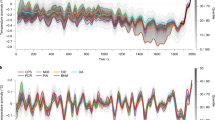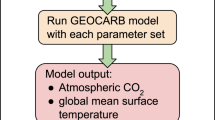Abstract
There is a Brief Communications Arising (01 March 2007) associated with this document
The magnitude and impact of future global warming depends on the sensitivity of the climate system to changes in greenhouse gas concentrations. The commonly accepted range for the equilibrium global mean temperature change in response to a doubling of the atmospheric carbon dioxide concentration1, termed climate sensitivity, is 1.5–4.5 K (ref. 2). A number of observational studies3,4,5,6,7,8,9,10, however, find a substantial probability of significantly higher sensitivities, yielding upper limits on climate sensitivity of 7.7 K to above 9 K (refs 3–8). Here we demonstrate that such observational estimates of climate sensitivity can be tightened if reconstructions of Northern Hemisphere temperature over the past several centuries are considered. We use large-ensemble energy balance modelling and simulate the temperature response to past solar, volcanic and greenhouse gas forcing to determine which climate sensitivities yield simulations that are in agreement with proxy reconstructions. After accounting for the uncertainty in reconstructions and estimates of past external forcing, we find an independent estimate of climate sensitivity that is very similar to those from instrumental data. If the latter are combined with the result from all proxy reconstructions, then the 5–95 per cent range shrinks to 1.5–6.2 K, thus substantially reducing the probability of very high climate sensitivity.
This is a preview of subscription content, access via your institution
Access options
Subscribe to this journal
Receive 51 print issues and online access
$199.00 per year
only $3.90 per issue
Buy this article
- Purchase on Springer Link
- Instant access to full article PDF
Prices may be subject to local taxes which are calculated during checkout



Similar content being viewed by others
References
Schneider, S. H. & Dickinson, R. E. Climate modeling. Rev. Geophys. Space Phys. 12, 447–493 (1974)
Cubasch, U., et al. in Climate Change 2001: The Scientific Basis (eds Houghton, J. T. et al.) 525–582 (Cambridge Univ. Press, New York, 2001)
Andronova, N. G. & Schlesinger, M. E. Causes of global temperature changes during the 19th and 20th centuries. Geophys. Res. Lett. 27, 2137–2140 (2000)
Gregory, J. M., Stouffer, R. J., Raper, S. C., Stott, P. A. & Rayner, N. A. An observationally based estimate of the climate sensitivity. J. Clim. 15, 3117–3121 (2002)
Forest, C. E., Stone, P. H., Sokolov, A. P., Allen, M. R. & Webster, M. D. Quantifying uncertainties in climate system properties with the use of recent observations. Science 295, 113–117 (2002)
Forest, C. E., Stone, P. H. & Sokolov, A. P. Estimated PDFs of climate system properties including natural and anthropogenic forcings. Geophys. Res. Lett. (in the press)
Knutti, R., Stocker, T. F., Joos, F. & Plattner, G.-K. Constraints on radiative forcing and future climate change from observations and climate model ensembles. Nature 416, 719–723 (2002)
Frame, D. J. et al. Constraining climate forecasts: The role of prior assumptions. Geophys. Res. Lett. 32, L09702, doi:10.1029/2004GL0022241 (2005)
Murphy, J. M. et al. Quantification of modelling uncertainties in a large ensemble of climate change simulations. Nature 430, 768–772 (2004)
Stainforth, D. A. et al. Uncertainty in predictions of the climate response to rising levels of greenhouse gases. Nature 433, 403–406 (2005)
Mann, M. E. & Jones, P. D. Global surface temperatures over the past two millennia. Geophys. Res. Lett. 30, 1820, doi:10.1029/2003GL017814 (2003)
Briffa, K. R. et al. Low-frequency temperature variations from a northern tree ring density network. J. Geophys. Res. 106, 2929–2941 (2001)
Esper, J., Cook, E. R. & Schweingruber, F. Low-frequency signals in long tree-ring chronologies for reconstructing past temperature variability. Science 295, 2250–2253 (2002)
Cook, E., Esper, J. & D'Arrigo, R. Extra-tropical Northern Hemisphere land temperature variability over the past 1000 years. Quat. Sci. Rev 23, 2063–2074 (2004)
Hegerl, G. C. et al. Detection of human influence on a new, validated 1500 yr temperature reconstruction. J. Clim. (submitted)
Moberg, A., Sonechkin, D. M., Holmgren, K., Datsenko, N. M. & Karlen, W. Highly variable Northern Hemisphere temperatures reconstructed from low- and high-resolution proxy data. Nature 433, 613–617 (2005)
von Storch, H. et al. Reconstructing past climate from noisy data. Science 306, 679–682 (2004)
North, G. R., Mengel, J. G. & Short, D. A simple energy balance model resolving the seasons and continents: Application to the astronomical theory of the ice ages. J. Geophys. Res. 88, 6576–6586 (1983)
Hegerl, G. C., Crowley, T. J., Baum, S. K., Kim, K.-Y. & Hyde, W. T. Detection of volcanic, solar, and greenhouse gas signals in paleo-reconstructions of Northern Hemispheric temperature. Geophys. Res. Lett. 30, 1242, doi:10.1029/2002GL016635 (2003)
Crowley, T. J., Baum, S. K., Kim, K.-Y., Hegerl, G. C. & Hyde, W. T. Modeling ocean heat content changes during the last millennium. Geophys. Res. Lett. 30, 1932, doi:10.1029/2003GL017801 (2003)
Crowley, T. J. & Kim, K.-Y. Modeling the temperature response to forced climate change over the last six centuries. Geophys. Res. Lett. 26, 1901–1904 (1999)
Li, Y.-H., Peng, T.-H., Broecker, W. S. & Oestlund, H. G. The average vertical mixing coefficient for the oceanic thermocline. Tellus B 36, 212–217 (1984)
Siegenthaler, U. Uptake of excess CO2 by an outcrop-diffusion model of the ocean. J. Geophys. Res. 88, 3599–3608 (1983)
Levitus, S., Antonov, J. & Boyer, T. Warming of the world ocean, 1955–2003. Geophys. Res. Lett. 32, L02604, doi:10.1029/2004GL021592 (2005)
Free, M. & Robock, A. Global warming in the context of the little Ice Age. J. Geophys. Res. 104, 19057–19070 (1999)
Stuiver, M. & Braziunas, T. F. Modeling atmospheric 14C influence and 14C ages of marine samples to 10,000 BC. Radiocarbon 35, 137–189 (1993)
Lean, J. L., Beer, J. & Bradley, R. Reconstruction of solar irradiance changes since 1610: Implications for climate change. Geophys. Res. Lett. 22, 3195–3198 (1995)
Lean, J. L., Wang, Y.-M. & Sheeley, N. R. The effect of increasing solar activity on the Sun's total open magnetic flux during multiple cycles: Implications for solar forcing of climate. Geophys. Res. Lett. 29, 2224, doi:10.1029/2002GL015880 (2002)
Shindell, D. T., Schmidt, G. A., Mann, M. E. & Faluvegi, G. Dynamic winter climate response to large tropical volcanic eruptions since 1600. J. Geophys. Res. 109, D05104, doi:10.1029/2003JD004151 (2004)
Thompson, D., Wallace, J. M. & Hegerl, G. C. Annular modes in the extratropical circulation: Part II, Trends. J. Clim. 13, 1018–1036 (2000)
Acknowledgements
We thank C. Forest for suggesting merging PDF estimates from results based on past-millennium climate changes with those based on twentieth-century climate change; J. Kenyon for technical support; M. Allen, F. Zwiers, A. Gelfand and M. Lavine for discussions; and C. Forest, N. Andronova, R. Knutti and J. Gregory for providing data. G.C.H. and T.J.C. were supported by NOAA, NOAA's office of global programmes and the DOE's office of biological and environmental research. G.C.H. was additionally supported by NSF. Author Contributions G.C.H. developed and implemented the method to estimate sensitivity and to calibrate proxy records, T.J.C. provided the reconstruction of past forcing and developed the CH-blend reconstruction, W.T.H. performed the EBM simulation, and D.J.F. derived the prior estimate of sensitivity from instrumental data 1950–2000. G.C.H., T.J.C. and W.T.H analysed the results.
Author information
Authors and Affiliations
Corresponding author
Ethics declarations
Competing interests
Reprints and permissions information is available at npg.nature.com/reprintsandpermissions. The authors declare no competing financial interests.
Supplementary information
Supplementary Notes
This file discusses detailed Supplementary Methods, with estimates and models and references. It contains Supplementary Figures 1–5 and Supplementary Tables 3 and 4, and also legends for Supplementary Tables 1 and 2. (PDF 973 kb)
Supplementary Table 1
These files contain our new reconstructions and their 2.5% and 97.5% uncertainty ranges, and thus contain data necessary to reproduce our result. Both the baseline reconstruction CH-blend and the longer, less densely sampled reconstruction CH-blend (long) are attached here. The files are organized as Year/ Central value/ Upper 97.5th percentile/Lower 2.5th percentile. The uncertainty ranges reflect both uncertainty in the amplitude of the reconstruction, and sampling uncertainty combined. *Supplementary Table 1 and its heading have been replaced on 5 February 2007. This is a corrected version of the previous Table S1, in which only the scaling uncertainty was included; in the corrected Table S1, scaling and sampling uncertainties are now included. (XLS 15 kb)
Supplementary Table 2
Gives the forcing data for greenhouse gas, solar, volcanic and aerosol forcing used in the simulations. It also contains data necessary to reproduce our result. (XLS 86 kb)
Rights and permissions
About this article
Cite this article
Hegerl, G., Crowley, T., Hyde, W. et al. Climate sensitivity constrained by temperature reconstructions over the past seven centuries. Nature 440, 1029–1032 (2006). https://doi.org/10.1038/nature04679
Received:
Accepted:
Published:
Issue Date:
DOI: https://doi.org/10.1038/nature04679
This article is cited by
-
Prediction of surface temperature and CO2 emission of leading emitters using grey model EGM (1,1, α, θ)
Environmental Science and Pollution Research (2023)
-
Climate Sensitivity and Ecoclimate Sensitivity: Theory, Usage, and Past Implications for Future Biospheric Responses
Current Climate Change Reports (2022)
-
The socioeconomic effects of extreme drought events in northern China on the Ming dynasty in the late fifteenth century
Climatic Change (2021)
-
An observation-based scaling model for climate sensitivity estimates and global projections to 2100
Climate Dynamics (2021)
-
Demographic Crises of Different Climate Phases in Preindustrial Northern Hemisphere
Human Ecology (2020)
Comments
By submitting a comment you agree to abide by our Terms and Community Guidelines. If you find something abusive or that does not comply with our terms or guidelines please flag it as inappropriate.



